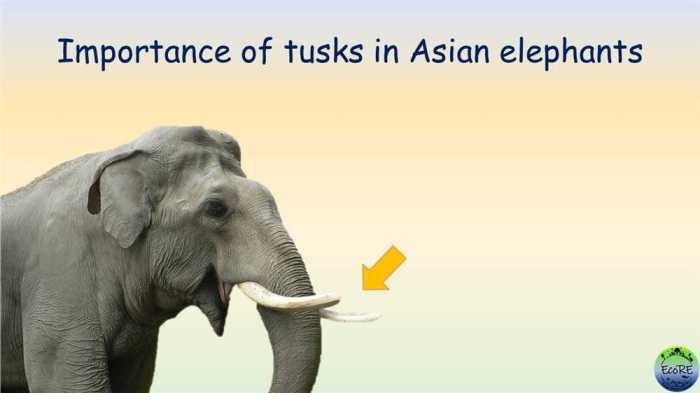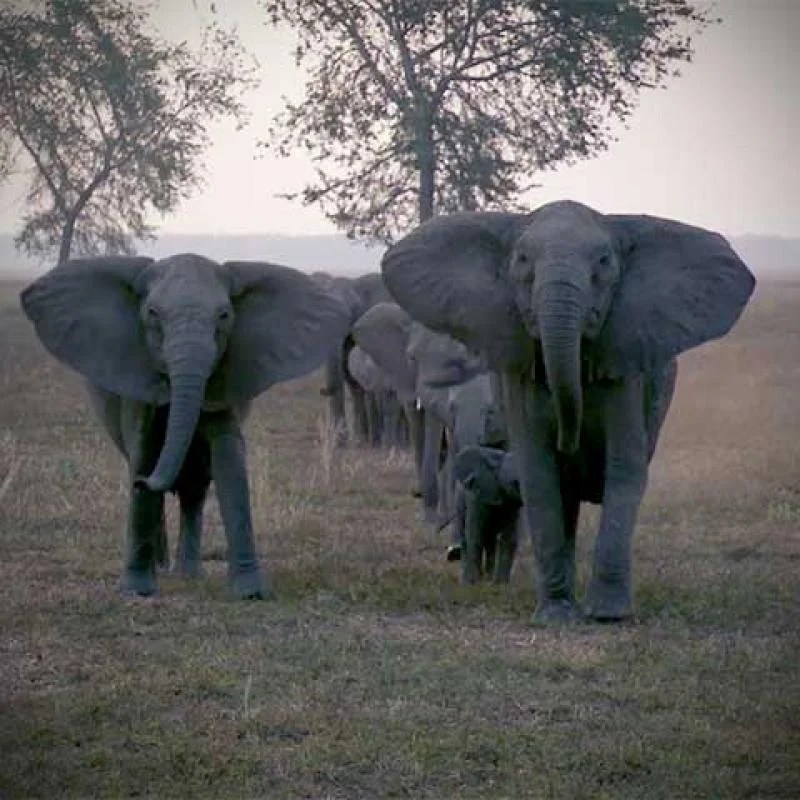Analyzing data on tuskless elephants unveils a captivating tale of evolutionary adaptation, challenging conventional wisdom and shedding light on the remarkable resilience of these unique creatures. By delving into their genetic makeup, population dynamics, and ecological interactions, we uncover the intricate mechanisms that govern their survival and the profound implications for their conservation.
This in-depth analysis reveals the evolutionary advantages and disadvantages of tusklessness, the diverse methods employed for data collection, and the complex factors influencing population growth and decline. It further explores the habitat preferences and behavioral adaptations of tuskless elephants, highlighting the critical role they play within their ecosystems.
Tusked vs. Tuskless Elephants

Tuskless elephants are a distinct phenotype characterized by the absence of tusks. This trait is predominantly observed in female elephants, with only a small percentage of males exhibiting tusklessness. The genetic basis for tusklessness has been attributed to a dominant X-linked gene, suggesting that it is inherited from the mother.
Evolutionary Advantages of Tusklessness, Analyzing data on tuskless elephants
Tusklessness provides certain evolutionary advantages. Tusks are primarily used for defense against predators and intraspecific competition. However, in areas where these threats are minimal, tusklessness can be beneficial as it reduces the risk of injury and energy expenditure associated with maintaining and using tusks.
Evolutionary Disadvantages of Tusklessness
Despite the advantages, tusklessness also has some evolutionary disadvantages. Tusks play a crucial role in various aspects of elephant behavior, including foraging, digging, and manipulating objects. Tuskless elephants may face challenges in accessing certain food sources and performing specific tasks that require tusks.
Impact on Elephant Populations
The prevalence of tusklessness in elephant populations can have significant implications for their survival and conservation. In areas where poaching is prevalent, tusklessness may provide a survival advantage as it reduces the risk of being targeted by poachers. However, in regions where tusks are important for survival, tusklessness can negatively impact elephant populations by reducing their ability to compete for resources and defend themselves against predators.
Conclusion
Tusklessness in elephants is a genetically inherited trait with both evolutionary advantages and disadvantages. The presence and prevalence of tuskless individuals in elephant populations can influence their survival, behavior, and overall population dynamics.
Data Collection Methods

Data collection on tuskless elephants involves employing various methodologies, each with its own advantages and limitations. These methods include:
Field Observations
- Direct Observation:Researchers directly observe elephants in their natural habitats, recording data on tusk presence or absence, herd composition, and behavior.
- Indirect Observation:Signs of elephant presence, such as footprints, dung, and feeding marks, are analyzed to infer the presence of tuskless individuals.
Camera Traps
- Remote Sensing:Camera traps are placed in strategic locations to capture images of elephants, allowing for the identification of tuskless individuals.
- Advantages:Provides non-invasive data collection, allows for long-term monitoring, and captures images for visual confirmation.
- Limitations:Can be expensive to deploy and maintain, may miss elephants that avoid cameras, and image quality can be affected by environmental conditions.
Genetic Sampling
- DNA Analysis:Genetic samples from elephants, such as blood, hair, or dung, can be analyzed to determine the presence of tuskless genes.
- Advantages:Provides accurate identification of tuskless individuals, allows for the study of genetic inheritance, and can be used to track populations over time.
- Limitations:Requires invasive sampling techniques, can be costly, and may not always be feasible in remote areas.
Population Dynamics
The population dynamics of tuskless elephants, particularly in Africa, are complex and influenced by various factors. Understanding these dynamics is crucial for conservation efforts and the preservation of genetic diversity within elephant populations.
Population Trends
Population trends of tuskless elephants vary across different regions. In some areas, populations have been declining due to poaching and habitat loss. In contrast, other regions have witnessed a stable or even increasing population of tuskless elephants, suggesting that tusklessness may confer certain survival advantages.
Factors Influencing Population Growth and Decline
Several factors influence the population growth and decline of tuskless elephants. These include:
- Poaching:Tuskless elephants are often targeted by poachers due to their perceived lower value compared to tusked elephants. This selective poaching can lead to population decline.
- Habitat Loss:The loss of natural habitats due to deforestation, agriculture, and urbanization can reduce the carrying capacity for elephants, leading to population decline.
- Genetic Factors:Tusklessness is a heritable trait, meaning that it can be passed down from generation to generation. In areas where tusklessness is prevalent, the population may exhibit a higher proportion of tuskless individuals.
- Survival Advantages:Some studies suggest that tuskless elephants may have certain survival advantages in specific environments. For example, they may be less vulnerable to injury during aggressive encounters or may have an advantage in foraging in dense vegetation.
Habitat and Behavior
Tuskless elephants exhibit distinct habitat preferences and behavioral adaptations compared to their tusked counterparts. Understanding these differences provides valuable insights into the ecological and social dynamics of elephant populations.
Habitat Preferences
- Tuskless elephants often inhabit areas with dense vegetation, such as forests and woodlands, where they can utilize their trunks for foraging and defense.
- They may also be found in grasslands and savannas, where they rely on their keen senses and social bonds for protection.
- Their habitat selection is influenced by factors such as food availability, water sources, and protection from predators and human disturbance.
Behavioral Adaptations
The absence of tusks significantly affects the behavior of tuskless elephants, particularly in terms of foraging and social interactions.
- Foraging:Tuskless elephants have developed specialized foraging techniques. They use their trunks to strip bark from trees, dig up roots, and pluck leaves, which requires greater dexterity and effort compared to tusked elephants.
- Social Dynamics:Tuskless elephants may face social challenges within herds. Tusks play a crucial role in dominance hierarchies and courtship rituals, and their absence can impact an individual’s status and reproductive success.
Conservation Implications

Tuskless elephant populations face unique conservation challenges due to their distinct characteristics and vulnerability to poaching. Understanding the threats they face and developing targeted conservation strategies is crucial for their long-term survival.
Threats to Tuskless Elephant Populations
- Poaching:Tusked elephants are primarily targeted for their ivory, but tuskless elephants are often killed in the process, as they may be mistaken for males or females carrying ivory.
- Habitat loss and fragmentation:Human activities, such as deforestation and urbanization, reduce the availability of suitable habitat for elephants, forcing them into smaller and isolated populations.
- Human-elephant conflict:As elephant populations expand into human-dominated areas, they come into conflict with farmers, leading to crop damage and sometimes retaliation.
- Genetic diversity loss:Tuskless elephants have a reduced gene pool, which can make them more susceptible to diseases and environmental changes.
Conservation Strategies for Tuskless Elephants
To protect and manage tuskless elephant populations, conservationists are implementing various strategies:
- Anti-poaching measures:Increased surveillance, ranger patrols, and community-based anti-poaching efforts are essential to reduce poaching.
- Habitat conservation:Establishing protected areas and promoting sustainable land-use practices help maintain elephant habitats.
- Human-elephant conflict mitigation:Implementing measures such as electric fences, beehive fences, and crop insurance programs can reduce conflict and foster coexistence.
- Genetic management:Introducing tusked individuals into tuskless populations can increase genetic diversity and reduce the risk of inbreeding.
- Education and awareness:Raising awareness about the importance of tuskless elephants and their conservation needs is crucial for public support.
Cultural and Societal Impacts

Tuskless elephants hold cultural significance in various societies, influencing art, mythology, and traditional beliefs. In some African cultures, they are revered as symbols of wisdom, fertility, and strength. Conversely, in certain Asian cultures, they are associated with misfortune or divine punishment.
Ethical Considerations in Conservation
The ethical implications of tuskless elephant conservation are complex. Some argue that their unique genetic traits warrant protection as a distinct subspecies. Others contend that conservation efforts should prioritize protecting tusked elephants, as they face greater poaching threats. The debate highlights the need for balancing genetic preservation with the overall well-being of elephant populations.
Future Research Directions
To enhance our understanding of tuskless elephants and their ecological significance, several research gaps need to be addressed. Future studies should focus on exploring these gaps to provide a more comprehensive picture of these unique animals.
One important area for future research is investigating the genetic basis of tusklessness. While studies have suggested a genetic component, the specific genes and mechanisms involved are still not fully understood. Identifying the genetic basis of tusklessness would provide valuable insights into the evolutionary history and inheritance patterns of this trait.
Behavioral and Ecological Impacts
Another area that requires further exploration is the behavioral and ecological impacts of tusklessness. Studies have shown that tuskless elephants exhibit different behaviors and ecological roles compared to tusked individuals. However, the long-term consequences of tusklessness on their survival, reproduction, and interactions with other species are not fully understood.
Future research should investigate these aspects to determine the potential implications of tusklessness on elephant populations and ecosystems.
Conservation Strategies
Given the increasing prevalence of tusklessness, it is crucial to develop effective conservation strategies that take into account the unique challenges faced by these elephants. Future research should focus on identifying appropriate conservation measures, such as targeted anti-poaching efforts, habitat protection, and community-based conservation initiatives.
These studies should aim to mitigate the threats faced by tuskless elephants and ensure their long-term survival.
General Inquiries: Analyzing Data On Tuskless Elephants
What are the primary factors influencing the population decline of tuskless elephants?
Habitat loss, poaching, and human-wildlife conflict are among the key drivers of population decline in tuskless elephants.
How does tusklessness impact the behavior of elephants?
Tusklessness can affect feeding habits, social interactions, and reproductive success, as tusks play a vital role in various aspects of elephant behavior.
What are the ethical considerations surrounding the conservation of tuskless elephants?
Ethical considerations include the potential impact of genetic manipulation, the rights of animals, and the balance between conservation efforts and human needs.
